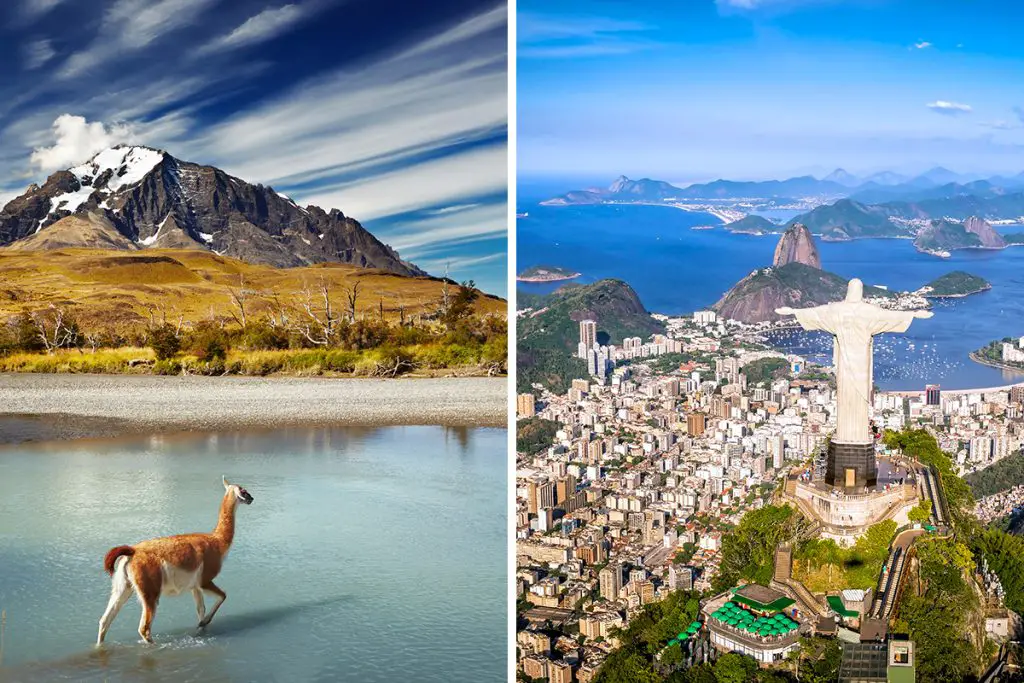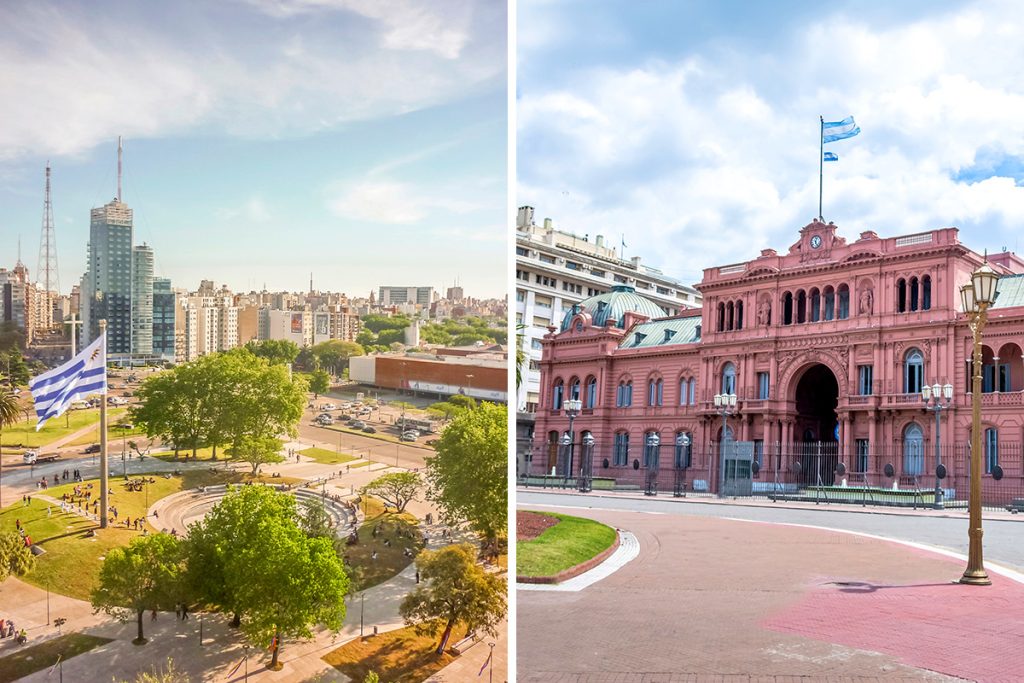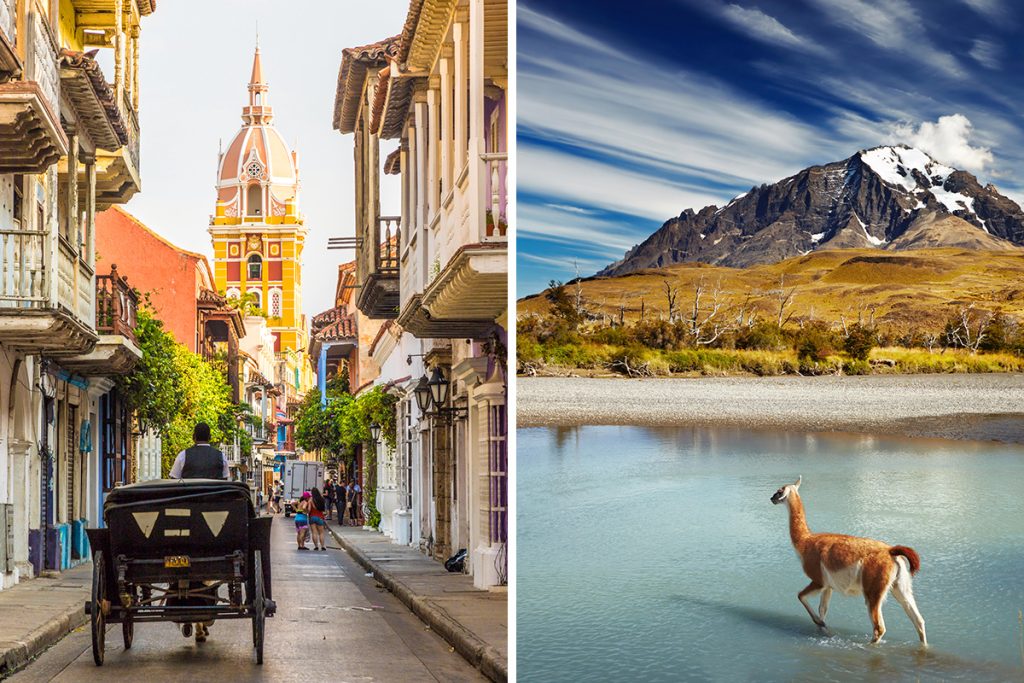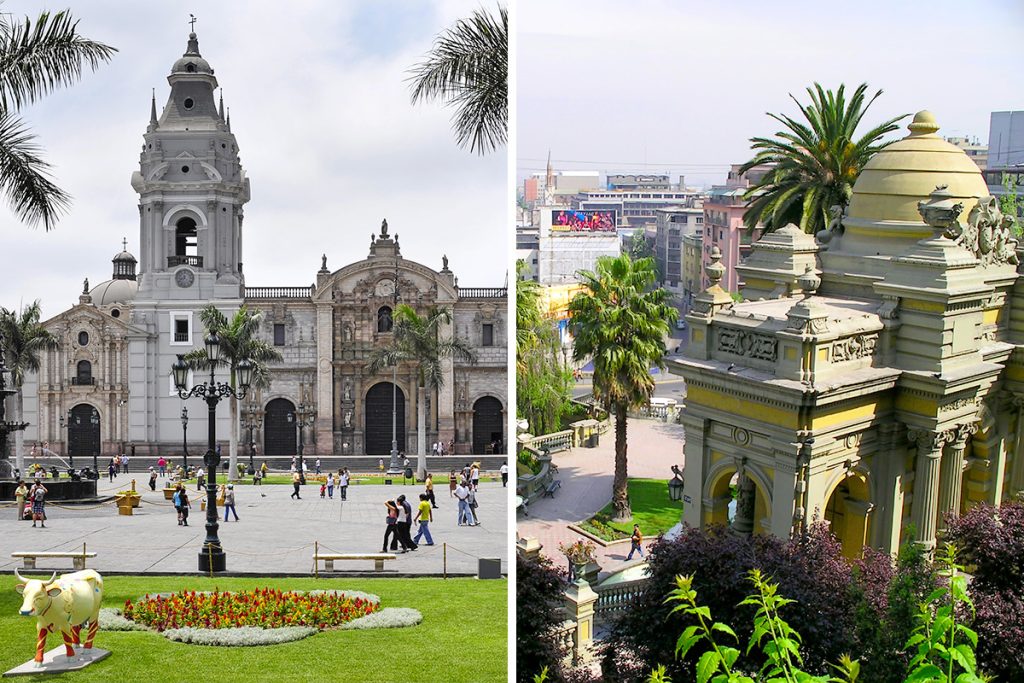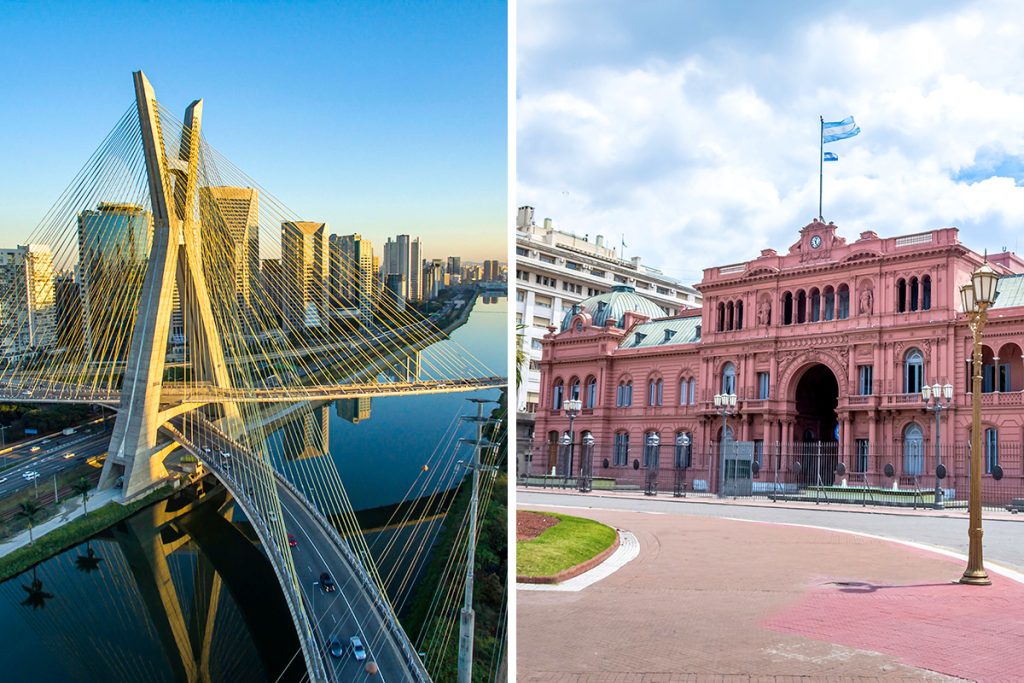Embarking on a journey to either Santiago or Buenos Aires is like stepping into different eras of time, each with its own unique narrative. The calm demeanor of Santiago’s streets has tales of ancient civilizations whispering through the breezes, while Buenos Aires throbs with a lively tango rhythm that narrates its colorful history. Delve deeper into the soul of these two cities as we unravel the threads of their histories and cultures in the following comparisons.
History & Culture
Your journey into the heart of Santiago’s and Buenos Aires’ past begins with a glimpse into their historical timelines.
Santiago, founded in 1541, has been a witness to the evolution of Chile from a colonial outpost to a blossoming modern nation. The city’s architecture is a quaint blend of colonial Spanish influences and modernist designs.
Buenos Aires, on the other hand, established in 1536, saw the colorful interplay of native cultures and European influences, creating a vibrant mosaic that is reflected in its cityscape today.
As you meander through Santiago’s streets, you’ll feel a calm rhythm that resonates with its historical roots. The city has gracefully balanced its past with the present, creating a tranquil ambiance. Buenos Aires has a contrasting vibe; it’s a city that never sleeps, where the echoes of its eventful past reverberate in the lively beats of tango that fill the night air.
Your exploration deepens as you unearth the cultural ethos that defines each city.
Santiago is known for its refined cultural scene, with a plethora of museums, galleries, and theaters that reflect the city’s deep-rooted traditions. Buenos Aires, famed for its passionate tango culture, offers a more extroverted cultural display. The city is a hub for music, dance, and theater, embodying a spirited expression of its history.
The language of art speaks volumes about the identity of these two cities. Santiago’s more conservative and traditional artistic expressions contrast sharply with the bold and dynamic creativity seen in Buenos Aires. The latter’s open embrace of avant-garde ideas has positioned it as a leading cultural capital in South America.
In summary, the historical and cultural journey through Santiago and Buenos Aires offers a fascinating insight into the nuanced differences between serene traditionalism and energetic modernism. The choice between a tranquil exploration in Santiago and a lively adventure in Buenos Aires will ultimately hinge on your personal affinity towards either the calm or the lively narrative that each city voices. Your escapade awaits!
Attractions & Activities
The soul of a city is often reflected in the attractions it hosts and the activities it offers. Santiago and Buenos Aires, despite their geographical proximity, unfold vastly different experiences waiting to be discovered. As we journey through the heart of these cities, the unique signature of each reveals itself in every corner.
In Santiago, the blend of natural and urban attractions is striking. Venture to the peak of San Cristobal Hill where a giant statue of the Virgin Mary welcomes you, and the city’s skyline stretches below. Take a leisurely stroll through the historic center, where Plaza de Armas and the majestic Metropolitan Cathedral stand as silent witnesses to Santiago’s rich past.
Your adventurous spirit might also find solace in hiking trails of the nearby Andes mountains, offering a blend of nature and tranquility amidst the urban hustle.
Buenos Aires, on the flip side, exudes a different kind of energy. The city invites you to explore its iconic neighborhoods like La Boca and San Telmo, each narrating a unique tale of the city’s vibrant culture. The architectural marvel of Teatro Colon awaits your admiration, and the haunting beauty of Recoleta Cemetery narrates tales of the city’s illustrious residents.
Your footprints on the dance floor will echo the city’s love for Tango as you sway to its rhythm in a traditional Milonga.
The contrasting palette of attractions and activities in Santiago and Buenos Aires is akin to a rich tapestry. While Santiago offers a more laid-back exploration intertwined with nature’s serenity, Buenos Aires promises a journey filled with rhythm, color, and architectural wonders.
In essence, your heart’s desire for adventure or tranquility will steer your compass towards Santiago or Buenos Aires. The understated charm of Santiago’s attractions and the energetic pulse of Buenos Aires’ activities present a compelling case for either destination. Your adventure in either city is bound to be nothing short of enriching.
Beaches
The allure of a city often extends to its coastline, offering a blend of urban charm and natural allure. While neither Santiago nor Buenos Aires are coastal cities, their proximity to captivating beaches is undeniably a part of their appeal.
Santiago, nestled amidst mountainous terrain, is a few hours’ drive from the Pacific coast. The closest beach, Santo Domingo, is about 114.9 kilometers (71.5 miles) away, offering a serene escape from the city’s urban landscape. The quaint beach town invites you to relax by the waves, with a cooler climate providing a refreshing respite.
On the other hand, Buenos Aires, situated nearer to the Atlantic Ocean, has beaches like Mar del Plata at a distance of 404.7 kilometers (251.5 miles). Known for its vibrant atmosphere, Mar del Plata offers a more lively beach experience with a myriad of activities to indulge in beside the tranquil ocean waves.
The contrasting beach experiences near Santiago and Buenos Aires add another layer to the unique essence of these cities. Santiago’s nearby beaches offer a peaceful retreat, while those near Buenos Aires promise a more dynamic ambiance.
In conclusion, the beaches near Santiago and Buenos Aires extend the unique charm of these cities to their nearby shores. Whether you seek a calm retreat or a lively escape, the beaches near these cities offer a beautiful extension of their contrasting personas. Your seaside adventure beckons!
Eating, Drinking & Nightlife
The culinary scene and nightlife of a city are the pulse that reflects its lifestyle and traditions. As you traverse the gastronomic trails of Santiago and Buenos Aires, you’ll be enveloped in an array of flavors and experiences that mirror the ethos of each city.
In Santiago, the food culture is a blend of traditional Chilean flavors with a dash of cosmopolitan influences. Here, you’ll find a range of eateries offering hearty meals like pastel de choclo (corn casserole) and empanadas. The city’s markets, such as Mercado Central, are a haven for those wanting to explore the local produce and fresh seafood.
Transitioning to the drinking culture, Santiago has a growing craft beer scene, but it’s the country’s signature drink, Pisco, that takes center stage. A sip of a well-made Pisco Sour is a rite of passage while exploring the city’s bars and pubs.
Buenos Aires, with its rich culinary heritage, offers a stark contrast. The city is a haven for meat lovers, with Parrillas (steak houses) dotting the streets, offering a taste of the famed Argentine steaks.
The wine culture in Buenos Aires is robust, with Malbec being a popular choice among locals and visitors alike. A visit to a local wine bar is an invitation to explore the country’s rich wine heritage.
When the sun sets, Buenos Aires pulsates with an energetic nightlife. The city lives up to its moniker of ‘the city that never sleeps’, with a plethora of nightclubs and dance halls where the rhythm of Tango carries through the night.
In summary, Santiago offers a modest yet heartwarming culinary and night scene, while Buenos Aires provides a more vibrant and hearty experience. The gastronomic journey through these cities is akin to exploring their very essence, each bite and sip telling a story of the city’s heritage and lifestyle.
Shopping
The act of shopping often unfolds the lifestyle and craft of a city. Santiago and Buenos Aires, with their unique cultural imprints, offer a diverse shopping experience that speaks volumes about their craftsmanship and style.
Santiago boasts an array of artisan markets like Los Dominicos, where the skilled work of local craftsmen is showcased. From handcrafted jewelry to intricately designed pottery, the markets are a testament to Chile’s rich craft tradition.
On the other hand, Buenos Aires, with its cosmopolitan flair, offers a blend of high-end boutiques and antique shops. The city’s vibrant fashion scene is palpable in the trendy Palermo Soho neighborhood, where boutiques showcase the creativity of local designers.
Both cities have their own version of a bustling flea market; Santiago’s Persa Bio-Bio and Buenos Aires’ Feria de San Telmo. These markets are a treasure trove for those seeking vintage finds and unique souvenirs.
While Santiago offers a more traditional shopping experience reflecting Chile’s artisan heritage, Buenos Aires invites a trendy, modern shopping experience infused with a touch of vintage charm.
In a nutshell, whether you’re seeking traditional crafts or modern designs, both Santiago and Buenos Aires cater to a spectrum of tastes. The shopping escapades in these cities are a journey through their cultural and modern identities, each purchase a memory etched in the essence of these South American gems.
Accommodation
The essence of a city’s hospitality is often mirrored in the accommodations it offers. Both Santiago and Buenos Aires provide a spectrum of stay options, each with its unique charm, catering to the diverse tastes of travelers.
Santiago’s accommodation landscape is a blend of historic charm and modern elegance. You’ll find quaint boutique hotels nestled in the heart of the city, offering a cozy retreat with a touch of local culture. Alternatively, modern high-rise hotels provide a touch of luxury with stunning views of the Andes mountains.
Buenos Aires, with its bohemian vibe, extends a different accommodation experience. The city boasts stylish boutique hotels in neighborhoods like Palermo and Recoleta, reflecting the city’s artistic and historical ethos. The grandeur of some of the city’s vintage hotels transports you back in time, encapsulating the city’s rich history.
Both cities offer a range of hostels and guesthouses, providing a comfy stay for budget travelers. The warmth and hospitality extended by these establishments often reflect the welcoming nature of the local culture.
The choice between Santiago and Buenos Aires extends to the kind of stay experience you seek – a modern, serene retreat in Santiago, or a vibrant, historical dive in Buenos Aires.
In summary, whether it’s the modern elegance of Santiago or the bohemian rhapsody of Buenos Aires, the accommodation in both cities promises a comforting and enriching stay, embodying the spirit of South American hospitality.
Family-Friendliness & Children’s Activities
A city’s charm for families often lies in how well it can keep the little ones engaged and enchanted. Santiago and Buenos Aires, with their distinct vibes, unfold a plethora of activities that promise a memorable family adventure.
In Santiago, family-friendly parks like Parque Bicentenario offer expansive green spaces for picnics and playful afternoons. The city’s numerous museums also provide interactive exhibits that are both educational and entertaining for children.
Buenos Aires, on the other hand, enchants with its lively street fairs and musical events. The city’s love for dance and music extends to family-friendly milongas where even the young ones can sway to the rhythm of Tango.
Outdoor enthusiasts will find joy in Buenos Aires’ ecological reserves, where families can explore walking trails and observe the local flora and fauna. Similarly, Santiago’s close proximity to nature reserves offers a retreat into nature’s lap.
Both cities provide a blend of educational, cultural, and outdoor activities that cater to families seeking a rich and engaging experience.
In a nutshell, Santiago and Buenos Aires beckon families with a promise of memorable adventures packed with learning, culture, and natural beauty, ensuring a delightful South American escapade.
Getting There & Getting Around
The ease of access and navigation through a city significantly influences the travel experience. Santiago and Buenos Aires, being prominent South American destinations, have well-established transit systems both for arriving and exploring the cityscapes.
To reach Santiago, the primary gateway is Arturo Merino Benitez International Airport, located 15 kilometers (9.3 miles) northwest of downtown. Similarly, Buenos Aires welcomes travelers through Ezeiza International Airport, situated 22 kilometers (13.7 miles) south of the city center.
Once in Santiago, the city’s efficient metro system and extensive bus network facilitate smooth transit across various neighborhoods. The bike-friendly nature of Santiago also encourages exploring the city on two wheels.
In contrast, Buenos Aires boasts a comprehensive public transit system comprising buses, subways, and commuter trains. The city also has a vibrant taxi culture, making it easy to hail a cab and explore at your own pace.
Both cities have embraced modern app-based ride-sharing services, further easing the process of getting around and discovering the numerous attractions each city has to offer.
In conclusion, whether you choose the orderly transit in Santiago or the bustling yet efficient commute options in Buenos Aires, your journey through the veins of these cities is bound to be an adventure in itself, painting a vivid picture of life in these South American jewels.
Weather
The weather often plays a pivotal role in shaping your experience in a city. Santiago and Buenos Aires, being in different geographical settings, present varying climate patterns that contribute to their unique ambiance.
Santiago experiences a Mediterranean climate with warm, dry summers and mild, wet winters.
The summer months from December to February see temperatures averaging between 57°F to 85°F (13.9°C to 29.4°C), providing a warm and pleasant atmosphere for outdoor explorations. Conversely, the winter months from June to August bring cooler temperatures ranging from 37°F to 57°F (2.8°C to 13.9°C), with occasional rainfall adding to the city’s serene ambiance.
On the other hand, Buenos Aires enjoys a humid subtropical climate with more consistent rainfall throughout the year. The summer, spanning December to February, is warm with temperatures oscillating between 65°F to 83°F (18.3°C to 28.3°C). The winter, from June to August, is mild and temperatures usually hover between 46°F to 61°F (7.8°C to 16.1°C).
The contrasting weather patterns of Santiago and Buenos Aires offer different backdrops for your adventures. Santiago’s dry summers and calm winters are juxtaposed against the warm, humid atmosphere that envelopes Buenos Aires.
In essence, your preference for a Mediterranean climate or a subtropical ambiance will guide your choice between Santiago and Buenos Aires. Each city’s weather paints a different yet equally captivating scene, allowing for a diverse range of experiences based on the season of your visit.
Safety
Safety is a paramount consideration that impacts the overall enjoyment of your travel. Santiago and Buenos Aires, while being relatively safe cities, exhibit different safety profiles that might influence your travel plans.
In Santiago, petty thefts and pickpocketing incidents are common in crowded areas and public transportation. It’s advisable to exercise standard precautionary measures such as keeping valuables secured and being vigilant in crowded places.
Buenos Aires also experiences petty crimes like pickpocketing, especially in tourist-centric areas. Being cautious with personal belongings and avoiding secluded areas at night are general safety tips for a hassle-free experience.
An evergreen safety concern in Santiago is its susceptibility to earthquakes, owing to its location in a seismic zone. Meanwhile, Buenos Aires, being on the estuary of the Rio de la Plata, occasionally faces flooding issues.
In a nutshell, while both cities require basic safety precautions against petty crimes, the unique geographical challenges posed by earthquakes in Santiago and flooding in Buenos Aires add an extra layer of consideration for travelers.
Cost
The cost of travel can significantly influence the choice between destinations. Comparing Santiago and Buenos Aires in terms of cost uncovers distinct aspects of each city, shedding light on their affordability.
In Santiago, a 3-course meal at a mid-range restaurant may cost around 22,000 Chilean Pesos (approximately USD 13), while in Buenos Aires, a similar meal might be priced at around 11,100 Argentine Pesos (approximately USD 12). The disparity extends to accommodation as well, with a night at a 3-star hotel in Santiago averaging around USD 130, whereas in Buenos Aires, it could be around USD 200.
Transportation costs are relatively lower in Buenos Aires with a one-way ticket on local transport costing around 30 Argentine Pesos (approximately USD 0.30), compared to Santiago where the price is 800 Chilean Pesos (approximately USD 1).
Summarizing, Buenos Aires emerges as a more cost-effective destination compared to Santiago, with lower prices on food, lodging, and transportation. Your budget can stretch further in Buenos Aires, allowing you to explore more without feeling the pinch.
Which Is Better – Santiago or Buenos Aires?
The enigmatic allure of Santiago and Buenos Aires captivates every traveler with its distinct charm. As we delve into various facets of these two cities, the unique essence of each unfolds, painting a vivid picture of what one can expect in either destination.
The historical and cultural tapestry of Santiago and Buenos Aires is rich and diverse. Santiago, with its serene traditionalism, offers a tranquil exploration into Chile’s past, whereas Buenos Aires throbs with a lively modernism, embracing a spirited expression of its history through music and dance.
When it comes to attractions and activities, Santiago’s calm demeanor and close proximity to nature provide a laid-back exploration. Conversely, Buenos Aires pulsates with vibrant neighborhoods, architectural marvels, and the rhythmic dance of Tango, offering a more extroverted experience.
The beach experience near both cities adds a different flavor to their profiles. While Santiago’s nearby beaches offer a peaceful retreat, Buenos Aires’ nearby coastlines promise a more dynamic ambiance with a myriad of activities beside the tranquil ocean waves.
The culinary scene and nightlife in Buenos Aires are more vibrant with its famed steakhouses and energetic nightlife, while Santiago offers a modest yet heartwarming culinary scene with a calm night ambiance.
The practical aspects like accommodation, family-friendliness, transit, and cost also play significant roles in shaping your decision. Buenos Aires emerges as a more cost-effective destination with a lively atmosphere, whereas Santiago offers a tranquil retreat with a blend of modern and traditional accommodations.
In essence, your choice between Santiago and Buenos Aires hinges on personal preferences. If a serene, historically rich, and nature-close experience entices you, Santiago is your go-to. On the flip side, if a lively, culturally vibrant, and cost-effective adventure resonates with you, Buenos Aires awaits with open arms. Both cities, with their unique flavors and experiences, promise a memorable South American escapade, each resonating with the diverse chords of life, culture, and natural beauty.


